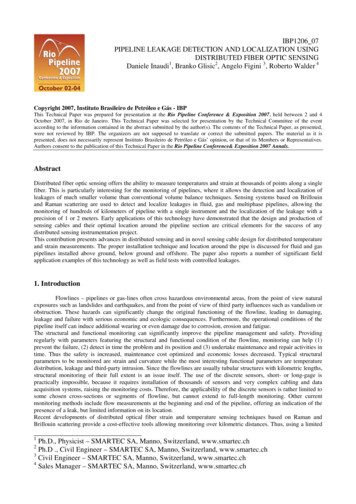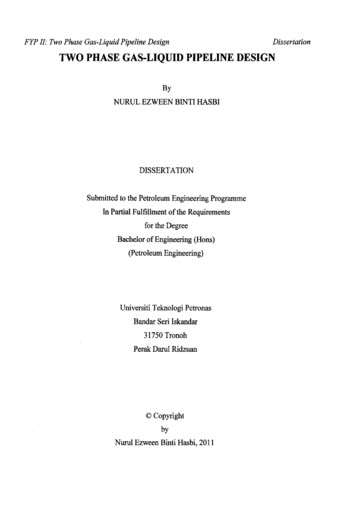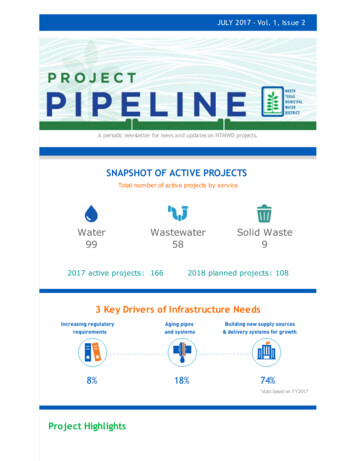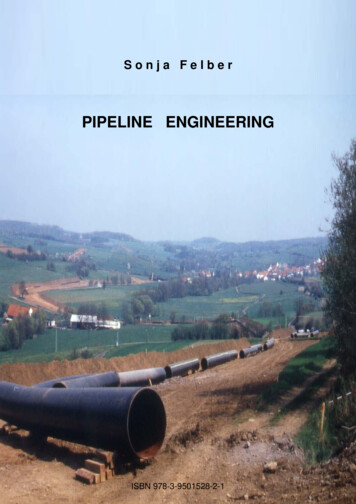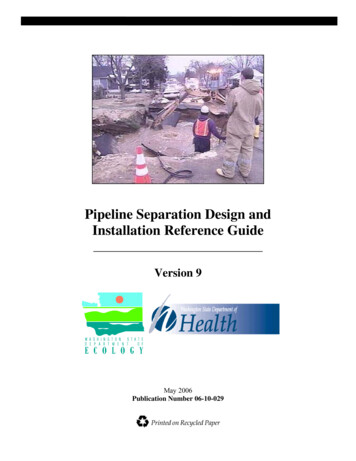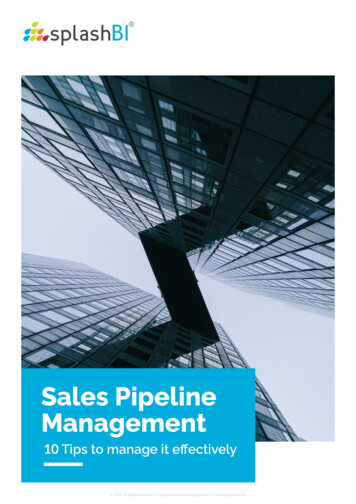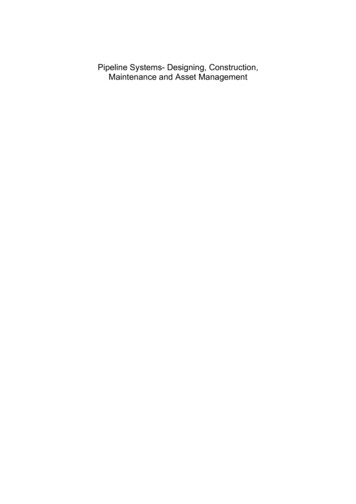
Transcription
Pipeline Systems- Designing, Construction,Maintenance and Asset Management
THIS BOOK WAS DEVELOPED BY IDC TECHNOLOGIESWHO ARE WE?IDC Technologies is internationally acknowledged as the premier provider of practical, technical trainingfor engineers and technicians.We specialize in the fields of electrical systems, industrial data communications, telecommunications,automation and control, mechanical engineering, chemical and civil engineering, and are continuallyadding to our portfolio of over 60 different workshops. Our instructors are highly respected in their fieldsof expertise and in the last ten years have trained over 200,000 engineers, scientists and technicians.With offices conveniently located worldwide, IDC Technologies has an enthusiastic team of professionalengineers, technicians and support staff who are committed to providing the highest level of training andconsultancy.TECHNICAL WORKSHOPSTRAINING THAT WORKSWe deliver engineering and technology training that will maximize your business goals. In today’scompetitive environment, you require training that will help you and your organization to achieve its goalsand produce a large return on investment. With our ‘training that works’ objective you and yourorganization will: Get job-related skills that you need to achieve your business goals Improve the operation and design of your equipment and plant Improve your troubleshooting abilities Sharpen your competitive edge Boost morale and retain valuable staff Save time and moneyEXPERT INSTRUCTORSWe search the world for good quality instructors who have three outstanding attributes:1. Expert knowledge and experience – of the course topic2. Superb training abilities – to ensure the know-how is transferred effectively and quickly to you ina practical, hands-on way3. Listening skills – they listen carefully to the needs of the participants and want to ensure that youbenefit from the experience.Each and every instructor is evaluated by the delegates and we assess the presentation after every class toensure that the instructor stays on track in presenting outstanding courses.HANDS-ON APPROACH TO TRAININGAll IDC Technologies workshops include practical, hands-on sessions where the delegates are given theopportunity to apply in practice the theory they have learnt.REFERENCE MATERIALSA fully illustrated workshop book with hundreds of pages of tables, charts, figures and handy hints, plusconsiderable reference material is provided FREE of charge to each delegate.ACCREDITATION AND CONTINUING EDUCATIONSatisfactory completion of all IDC workshops satisfies the requirements of the International Associationfor Continuing Education and Training for the award of 1.4 Continuing Education Units.IDC workshops also satisfy criteria for Continuing Professional Development according to therequirements of the Institution of Electrical Engineers and Institution of Measurement and Control in theUK, Institution of Engineers in Australia, Institution of Engineers New Zealand, and others.
CERTIFICATE OF ATTENDANCEEach delegate receives a Certificate of Attendance documenting their experience.100% MONEY BACK GUARANTEEIDC Technologies’ engineers have put considerable time and experience into ensuring that you gainmaximum value from each workshop. If by lunchtime on the first day you decide that the workshop is notappropriate for your requirements, please let us know so that we can arrange a 100% refund of your fee.ONSITE WORKSHOPSAll IDC Technologies Training Workshops are available on an on-site basis, presented at the venue ofyour choice, saving delegates travel time and expenses, thus providing your company with even greatersavings.OFFICE LOCATIONSAUSTRALIA CANADA INDIA IRELAND MALAYSIA NEW ZEALAND POLAND SINGAPORE SOUTH AFRICA UNITED KINGDOM UNITED STATESidc@idc-online.comwww.idc-online.comVisit our website for FREE Pocket GuidesIDC Technologies produce a set of 6 Pocket Guides used bythousands of engineers and technicians worldwide.Vol. 1 – ELECTRONICSVol. 4 – INSTRUMENTATIONVol. 2 – ELECTRICALVol. 5 – FORMULAE & CONVERSIONSVol. 3 – COMMUNICATIONS Vol. 6 – INDUSTRIAL AUTOMATIONTo download a FREE copy of these internationally best selling pocket guides go to:www.idc-online.com/downloads/
PresentsPipeline Systems- Design, Construction,Maintenance and Asset ManagementRevision 3.1N.S. Nandagopal B.Sc (Chem Eng), M.Sc, P.E.Website: www.idc-online.comE-mail: idc@idc-online.com
IDC Technologies Pty LtdPO Box 1093, West Perth, Western Australia 6872Offices in Australia, New Zealand, Singapore, United Kingdom, Ireland, Malaysia, Poland, United States ofAmerica, Canada, South Africa and IndiaCopyright IDC Technologies 2007. All rights reserved.First published 2007All rights to this publication, associated software and workshop are reserved. No part of this publicationmay be reproduced, stored in a retrieval system or transmitted in any form or by any means electronic,mechanical, photocopying, recording or otherwise without the prior written permission of the publisher. Allenquiries should be made to the publisher at the address above.ISBN: 978-1-921007-00-2DisclaimerWhilst all reasonable care has been taken to ensure that the descriptions, opinions, programs, listings,software and diagrams are accurate and workable, IDC Technologies do not accept any legal responsibilityor liability to any person, organization or other entity for any direct loss, consequential loss or damage,however caused, that may be suffered as a result of the use of this publication or the associated workshopand software.In case of any uncertainty, we recommend that you contact IDC Technologies for clarification or assistance.TrademarksAll terms used in this publication that are believed to be registered trademarks or trademarks are listedbelow:AcknowledgementsIDC Technologies expresses its sincere thanks to all those engineers and technicians on our trainingworkshops who freely made available their expertise in preparing this manual.
Contents1Introduction and 120Pipeline Design, Operation and Maintenance 123Pipeline Basics and Factors Influencing Pipeline DesignPipeline Route SelectionCode and Standards Affecting Pipeline Design,Construction, Operation and MaintenancePipeline Design Principles- Hydraulics, Mechanical Designand Materials of ConstructionPipeline Construction FundamentalsPipeline Protection and MaintenancePipeline EconomicsPhysical Quantities and Units used in Pipeline DesignCase StudySummaryCodes and SpecificationsList of Organizations involved in the Generation andPublication of Pipeline Codes and StandardsMajor Codes and Standards Governing the Design,operation and Maintenance of PipelineDevelopment of Codes and StandardsCommon Features of Pipeline Codes and StandardsFeatures of ASME B31.4: Pipeline Transportation Systemsfor Liquid Hydrocarbon and Other LiquidsFeatures of AS2885 (Australian Standard 2885):Pipelines- Gas and Liquid PetroleumSymbols and units Used in Pipeline Design StandardsAbbreviation Used in Pipeline Design StandardsInformation Typically Contained in Piping SpecificationsStandards and Guidelines for Pipeline Operation e Routing353.13.23.33.43.53536373738Introduction to Pipeline RoutingFactors Influencing Pipeline RoutingAcquisition of Land for Pipeline ConstructionPipeline Routing Thumb RulesTools Used in Pipeline Routing
3.63.73.83.94539394043Pipeline Hydraulics- Fluid Properties454.14.24550Fluid Properties and Their unitsSummaryLiquid Flow and 5558596061616363645.135.145.156Data Used in Pipeline RoutingConsideration of Alternate RoutesRoute Selection Case StudySummaryFundamentals of Liquid Flow: Continuity EquationLaminar Flow of LiquidsTurbulent Flow of LiquidsPump Basics and Types of PumpsCentrifugal PumpsReciprocating PumpsPump DriverPump Performance ParametersPump Calculations: Power RequirementsPump Calculations: Affinity lawsPump CavitationChanging Pump Parameters to Meet Fluctuations inPipeline Operating ConditionNet Positive Section Head (NPSH)Optimization of Line Size, Pressure Drop and Locationof Pumping StationSummary65656667Gas Flow and 1269717172737778818182836.136.146.15Calculation of Gas DensitiesContinuity Equation for Gas FlowCompressible Flow of GasesReynolds Number and Friction Factor for Gas FlowEquations for Gas Flow Through PipelinesGas CompressorsTypes of Gas Compressors and DriversSelection of Gas CompressorsIsothermal Gas CompressionReversible Adiabatic or Isentropic Gas CompressionPower Required for Gas CompressionAddition Gas Compression Equations for IsentropicCompressionGuidelines for Compressor Design and SelectionDesign Optimization of Gas PipelineCompressor Stations84848585
6.167987Mechanical Design of 107.117.127.137.148SummaryForces and Stresses in PipelinesIntroduction to Mechanical DesignMechanical Design ParametersCriteria for Mechanical Design including Code CriteriaSpecified Minimum Yield Strength of Pipeline MaterialsMechanical Design Equations: Calculations of MaximumAllowable Pressure (MAP) and Minimum Required WallThickness of PipelinesSustained Loads in PipelinesThermal Expansion/ Contraction of MaterialsStresses Due to Thermal Expansion/ ContractionQuick Estimate of Weight of PipelineEstimating the Maximum Span of Unsupported PipeEstimating Expansion/ Contraction of PipelineCase StudySummary9294959597979899100Pipeline 110110112112112114IntroductionSequence of Construction ActivitiesConstruction EquipmentPreparing of the Right of Way (ROW) for the PipelineStringing the PipelineBendingWelding and Post-Weld QualificationLoweringTie-in and AssemblyTesting and InspectionBack Filling of TrenchConstruction Techniques Used in Water CrossingCommissioning the PipelineCleaning and RestorationCase StudySummaryPipeline Protection and Maintenance1159.19.29.39.4115116116117Possible Causes of Pipeline DamageConsequences of Pipelines DamagePrevention of Pipeline DamageCharacteristics and Properties of Pipeline Coatings
line Economics and Asset on FundamentalsCathodic ProtectionInternal CorrosionStress Corrosion Cracking (SCC)Pipeline Integrity ProgramsCase StudySummaryIntroduction to Pipeline EconomicsTerminology Used in Pipeline EconomicsCase StudyPipeline Performance: Key Performance Indicators(KPIs) for Monitoring and Assessing ions to Practical ExercisesBAppendicesArticle175
1Introduction and OverviewThis chapter provides an introduction to the course and also a brief overview of thecourse topics. The objective of this chapter is to set the framework for the course andprovide the reader with a good feel of the topics covered in the course.Learning objectivesFundamental aspects of the following topics: Pipeline Basics and factors influencing Pipeline Design. Pipeline Route Selection. Codes and Standards Affecting Pipeline Design, Construction, Operationsand Maintenance. Pipeline Design Principles: Hydraulics, Mechanical Design and MaterialsSelection. Pipeline Construction Fundamentals. Pipeline Protection and Maintenance. Pipeline Economics. Physical Quantities and Units used in Pipeline Design. Practical Exercises. Comprehensive Case Study illustrating different aspects of pipeline design,operations and maintenance.1.1Pipeline Basics and Factors Influencing Pipeline DesignPipelines play a vital role in the transmission of oil and gas from the source to thedestination for further refining, processing and storage. Most of developed countrieshave an extensive pipeline network that help meet energy and product demands atdifferent locations. Pipeline construction and use is increasing at a rapid pace indeveloping nations. Pipelines traverse large distances and can be above ground or below
2 Pipeline Systems- Design, Construction, Maintenance and Managementground. Pipelines also cross bodies of water such as lakes and rivers. A picture of theTrans-Alaska pipeline is shown in Figure 1.1.Figure 1.1Trans-Alaska PipelineFacts on some well-known pipelines are presented in Table 1.1Table 1.1Facts on Some Well-Known PipelinesPipelineTrans-AlaskaLocationPrudhoe Bay toValdezCrude Oil800 miles1974 – 1977CommodityLengthConstr.DatesCostFeaturesStatus 7.7 billionExtreme Terrainand Climate,Permafrost,Environment2 million BPD atpeak (1988).890,000 BPD in2005Baku-Tbilisi-Ceyhan(BTC)Caspian Sea toMediterranean SeaCrude Oil1100 miles2003 – 2005 3.6 billionTraverses mountainranges, roads, railways,water bodies150,000 BPD in June2005. Will reduce by 350,the tankers throughBosphorus StraitWest-East GasXingjiang Uygur toShanghaiNatural Gas2500 miles2002 – 2004 5.2 billionTraverses threemountains, 37 rivers.Used remote sensingtechnology.1.3 billion cubicmeters of natural gasin 2004, its first yearof operation
Introduction and Overview3The design, construction, maintenance and operation of pipeline involve the use ofseveral engineering, scientific and economic principles. The location of the pipelinedepends on the location of the source of the commodity and its destination. The routingof the pipeline involves consideration of factors such as the terrain, topography, climateand the environment. Construction techniques are adopted to suit the terrain, the soil andthe environment. Compressor stations support the operation of gas transmission lines andpumping stations support pipelines transporting liquids.The major factors influencing the design and construction of pipelines are listed here. Nature of fluid being transported (gas or liquid) and fluid properties. Volume flow rate. Length of the pipeline. Terrain and medium (soil/water) traversed by the pipeline. Climatic conditions – extreme heat/cold. Environmental constraints and impact on the environment. Codes, standards and regulations governing the design, construction andoperation of the pipeline. Seismic/volcanic conditions. Flood plains and potential for flooding. Economics. Materials. Construction, operation and maintenance of the pipeline.The objective of pipeline design and engineering is to route, design and construct apipeline that can operate safely with minimal impact on the environment and one that iscost effective both in terms of capital and operating costs. To achieve this objective,sophisticated engineering and economic studies are necessary to optimize variables suchas pipeline routing, size (diameter), materials and compression/pumping requirements.1.2Pipeline Route SelectionThe pipeline is routed to connect the supply and delivery points in an optimal, costeffective manner keeping in mind the operational costs as well as the environmentalimpacts. The factors that influence pipeline routing are listed here. Location of supply and delivery points. Terrain and vegetation. Location of control points such as river crossings, mountain passes and denselypopulated areas. Location and nature of flood plains – usually pipelines should operatecontinuously under 1:50 year flood conditions and should not sustain majordamage from a 1:100 year flood. Construction access and constructability issues such as the ease with whichconstruction equipment can be moved in and out of suggested routing. Requirements and location of maintenance facilities such as pig launching andreceiving stations.Pipeline routing is an iterative process. The shortest route may not be the most costeffective. Engineering and design studies of the proposed alternative routes will have to
4 Pipeline Systems- Design, Construction, Maintenance and Managementbe under taken to optimize conflicting variables. After a preliminary routing isestablished, it is assessed with respect to the factors mentioned earlier. Some of the toolsand techniques used in the assessment of the preliminary routing are listed here. Geographical Information Systems (GIS). Detailed Surveying and its results. Land and soil data. Hydrological data (riverbed depth and flooding). Aerial reconnaissance and photographs. Satellite imaging and data. Site visits. Environmental impact studies and their findings.The preliminary routing is refined and adjusted as necessary based on the results of theroute assessment studies.1.3Codes and Standards Affecting Pipeline Design,Construction, Operation and MaintenanceSeveral codes and standards have been developed as guidelines for the design,construction and operation of pipelines. The objective of these codes and standards is toensure the safety of the personnel and the general public by minimizing the risks of highpressure pipelines. In addition to codes and standards, pipelines must followgovernmental regulations at different levels – federal, state (provincial) and local. Someof the international codes and standards that affect pipeline design, construction andoperation are listed here. In some cases a brief description is also provided. ASME B 31.8 – Gas Transmission and Distribution Piping Systems: This Codecovers the design, fabrication, installation, inspection, and testing of pipelinefacilities used for the transportation of gas. This Code also covers safety aspectsof the operation and maintenance of those facilities. ASME B 31.4 – Pipeline Transportation Systems for Liquid Hydrocarbons andother Liquids: This Code prescribes requirements for the design, materials,construction, assembly, inspection, and testing of piping transporting liquidssuch as crude oil, condensate, natural gasoline, natural gas liquids, liquefiedpetroleum gas, carbon dioxide, liquid alcohol, liquid anhydrous ammonia andliquid petroleum products between producers' lease facilities, tank farms,natural gas processing plants, refineries, stations, ammonia plants, terminals(marine, rail and truck) and other delivery and receiving points. AS 2885 - Australian Standard 2885 "Pipelines – Gas and Liquid petroleum."This code combines the features of many international and national standardsincluding ASME B31.8, CSA Z662, ISO 13623, API 1104, and ISO 13847.It has explicit requirements for the design, documentation, and approval of keyprocesses such as prevention of external interference, control of fracture, andwelding procedure qualification.It uses an integral risk assessment and threat mitigation process in design and inoperation and maintenance.
Introduction and Overview 1.45It adopts the requirements to suit the specific needs of Australian conditions oflonger distances, terrain and population densitiesAPI 5L – API (American Petroleum Institute) Specifications for Line Pipe:Covers welded and seamless pipe suitable for use in conveying gas, water, oil inboth the oil and natural gas industries.API 6D – Specifications for Pipeline Valves, End Closures, Connectors andSwivels: API 6D is the primary standard for valves used in pipeline service,including gate, plug, ball and check valves. This standard has more stringenttesting requirements.API 1104 – Welding of Pipeline and Related Facilities.ASTM A106 – Seamless Carbon Steel Pipe for High Temperature Service.NACE RP-01-92 – Control of External Corrosion on Underground orSubmerged Piping System.ISO 9001 – Quality Systems for Design/Development, Production, Installationand Servicing.API RP 5L2 – Recommended Practice for Internal Coating of Line Pipe for GasTransmission Service.Pipeline Design Principles – Hydraulics, Mechanical Designand Materials of ConstructionThe design and detailed engineering of pipelines requires the knowledge and applicationof fluid mechanics (hydraulics), stress analysis and materials science.The temperature and pressure of the fluid flowing in the pipeline are importantparameters that affect the fluid properties as well as the wall thickness and the insulationrequirements.Principles of fluid mechanics are used in the calculation of friction losses, pressure drop,and pumping requirements. Additionally, they are also used in the measurement andmetering of flow through the pipelines.Pipelines are subjected to forces resulting from internal pressure as well as other factorssuch as wind, thermal expansion, displacements, seismic movements and soil loads.These forces create stresses in the pipeline walls. The mechanical design of pipelinesuses the principles of stress analysis to calculate stresses within the pipeline and to ensurethat they are well within the allowable limits specified by the codes.The subject matter of thermodynamics covers topics related to principles of gascompression, pressure - temperature relationships for gas compression, energy and Powerrequirements for pumps and compressors.The nature of the commodity flowing in the pipeline and the surrounding environment(soil, water or above ground) determine the material to be used in the pipeline. Differentgrades of steel can be used depending on cost, wall thickness, welding requirements andtoughness. The subject matter of materials science covers the topics related to: selectionof appropriate materials for pipeline systems including pipe, valves, fittings, flanges,pumps and compressors, selection of appropriate insulation materials, principles ofcorrosion, techniques to minimize corrosion including cathodic protection.
6 Pipeline Systems- Design, Construction, Maintenance and Management1.5Pipeline Construction FundamentalsThe techniques used in the construction of pipelines depend on the nature of the routetraversed by the pipeline – above ground or below ground, the terrain, and crossing ofbodies of water, if any. Also, construction techniques are dependant on the season –techniques that are effective during summer may not be appropriate during winter.Construction operations and activities must comply with the regulations in effect alongthe pipeline route. Most of these regulations are intended to protect the environment andto promote public safety. Regulatory agencies conduct inspections to ensure compliance.Restoration of the environment to pre-construction status constitutes an important part ofconstruction activities. The optimization of construction costs takes place during theroute selection process. Common procedures and operations used during the constructionprocess are listed here. Construction Surveying. Trenching (if below ground). Clearing and grading the pipeline path (Right Of Way - ROW). Placing the pipe spools on the ROW. Stringing the pipe. Bending. Welding. Inspection of pipeline and welds using Non Destructive Testing (NDT)methods. Backfilling of trenches and restoring the site and the environment (revegetation).1.6Pipeline Protection and MaintenancePipelines are valuable assets that need to be protected and maintained for optimumperformance. The primary issue of concern for buried pipelines is external corrosion dueto the surrounding soil. The common methods of protecting buried pipelines are externalcoating and cathodic protection. External coatings are plastic materials placed on theexterior of the pipe using one of the following methods – wrapping, extrusion or fusionbonding. External coatings not only serve as barriers for corrosion attack but also preventdamage to pipeline during transportation, handling and backfilling. Insulation, rockshield and concrete are also used as external coatings. Cathodic protection involves theuse of a sacrificial anode or an impressed current that makes the pipeline the cathode.The method of protection employed depends on the nature and composition of the soil.This is determined by an analysis of the soil. During the design phase, the different typesof external coatings and cathodic systems are evaluated and an appropriate protectionstrategy is chosen based on soil conditions and economics.Corrosive substances, such as sour gas, being transported in the pipeline can also damagepipelines on the inside. The major problem is sulphide stress cracking (hydrogenembrittlement) caused by the presence of hydrogen sulphide (H2S). A betterunderstanding of the corrosion mechanism and the selection of appropriate material thatwill resist the corrosion will minimize internal corrosion problems.
Introduction and Overview7Despite all the care taken during the design and construction of pipelines, there is alwaysthe risk of damage to the pipelines. The damage can be mechanical damage due to otherequipment or forces due to soil movement. The damage could also be due to corrosion,mechanical defects and operational factors. This necessitates the monitoring of thepipeline to ensure the structural integrity and the operability of the pipeline. Thetechniques used in assessing the integrity of pipelines are listed here. Ultrasonic inspection. Radiography. Dye penetration tests. Magnetic particle testing. Cathodic protection survey. Magnetic flux. Visual inspection.1.7Pipeline EconomicsThe design, engineering and construction of pipelines require significant investment ofcapital and manpower. Further, the operating expenses of the pipeline also need to beconsidered. The capital costs and the operating costs are the two principal cost elementsin owning and operating a pipeline system. In the initial stages, an economic feasibilitystudy of the pipeline project is required to justify the investment in the pipeline. Duringsuch feasibility studies, alternative means of transporting the oil/gas by road or rail willalso be considered. The oil/gas can also be fed into an existing line. The alternative thatoffers the best return on the investment will be chosen. A sample problem involvingeconomic analysis of alternative means of transporting oil is illustrated in PracticalExercise 1.1.Practical Exercise 1.1The following data is available on three alternative methods for transporting oil. The costfigures are in millions of dollars. If the transmission company requires a minimum 6%return on investment, which alternative is most economically feasible? Use an analysisperiod of 30 years for comparison.AlternativeInitial Investment Annual Costs 50MRail Transport 60MLease an Existing Line 600M 5MNew Pipeline
8 Pipeline Systems- Design, Construction, Maintenance and ManagementPractical Exercise 1.2 illustrates the calculations of return on invested capital and paybackperiod for a pipeline project.Practical Exercise 1.2A pipeline project has an estimated capital investment of 600 M. The pipeline will beoperational in two years from the start of the construction. Once operational, the pipelinewill have projected annual revenue of 105 M for a period of 15 years. Annual operationcosts are expected to be 5 M.Determine:A. The rate of return for this pipeline project.B. The pay back period.Once the feasibility of a pipeline project is proven, further economic analysis is carriedout to determine the optimum value of variables such as pipeline diameter, material, wallthickness, routing and pumping/compression requirements. Economics affects almost alldesign and construction parameters. The results of economic analysis are also used indetermining the tariffs to be charged for transmission of commodities through thepipeline.Further details on the different cost factors and on pipeline economics are presented inChapter 6.1.8Physical Quantities and Units Used in Pipeline DesignThe design of pipelines involves engineering and design calculations. It is thereforeimportant to understand the physical quantities (variables) used in pipeline design andengineering calculations.The key to understanding the physical quantities is to know the definitions of force,pressure and engineering stress.Definitions of Force: Force is vector quantity that represents mass times acceleration.F m aThe unit of force in the metric system is kilogram force (kgf), which is defined as theforce required to accelerate 1 kilogram mass (kgm) at the rate of 9.81m/s2.The unit of force in the SI system is Newton (N), which is defined as the force required toaccelerate 1 kilogram mass (kgm) at the rate of 1m/s2.The unit of force in the imperial or US Customary System (USCS) is pound force (lbf),which is defined as the force required to accelerate 1 pound mass (lbm) at 32.2 ft/sec2.Note that subscripts “m” is used for mass units and subscript “f” is used for force units.
Introduction and Overview9Units of Force:1 N 1 kg 1ms21 kg f 1 kg m 9.811 lbf 1 lb m 32.2ms2g c 32.2ftsec 2lbm-ftlbf-sec 2The conversion factors for force units are:1 kgf 9.81 N, 1kgf 2.205 lbf, and 1lbf 4.4462 NPressure:Pressure is force per unit area and it acts uniformly on the surface.Units of Pressure: N/m2 (Pascal, Pa),lbf/in2 (psi), kgf/cm2, barAtmospheric pressure at sea level is101 kPa or 14.7 psiaCommonly used conversion factors for pressure are: 1 bar 105 N/m2 100 kPa1 lbf/in2 (psi) 0.0703 kgf/cm2 6.896 kPaTemperature:Units of Temperature ( F or C): F 1.8 ( C) 32, C ( F)(5/9) – 32Absolute temperature: Degree Rankine: R 460 F, Degree Kelvin: K 273 CMass Flow RateUnits of mass flow rate (lbm/hr or kgm/s): 1 kgm/s 132.3 lbm/hrThe mass flow rate will be the same at compressor/pump inlet and outlet as per the law ofconservation of mass.Volume flow rate or liquid/gas throughput:Units of volume flow rateLiquids: gallons per minute (gpm), Liters per second (L/s), cubic meters per hour (m3/hr),barrels per day (bpd).Useful conversion factors are:1 bpd 0.0066 m3/hr 0.0292 gpmGases: The volume of gas depends on the absolute pressure (gage pressure atmosphericpressure), and absolute temperature of the gas. The volume flow rate of gases is usuallyspecified in terms of Standard Cubic Feet Minute (SCFM – measur
Visit our website for FREE Pocket Guides IDC Technologies produce a set of 6 Pocket Guides used by thousands of engineers and technicians worldwide. Vol. 1 - ELECTRONICS Vol. 4 - INSTRUMENTATION Vol. 2 - ELECTRICAL Vol. 5 - FORMULAE & CONVERSIONS Vol. 3 - COMMUNICATIONS Vol. 6 - INDUSTRIAL AUTOMATION

